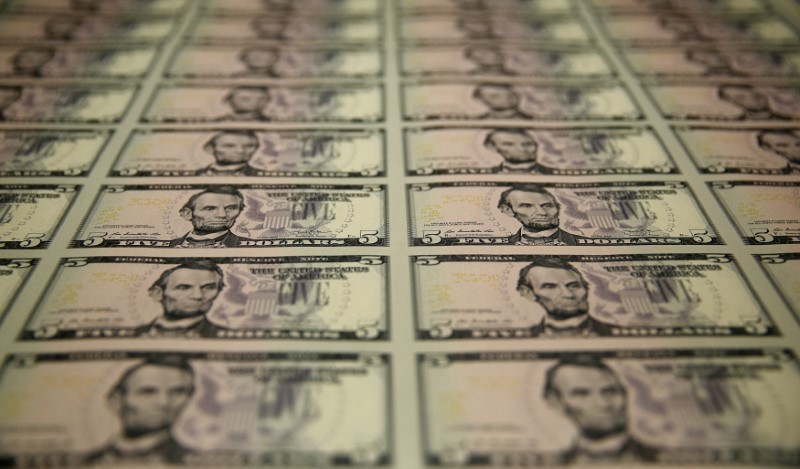 © Reuters. FILE PHOTO – Sheets of Lincoln five dollar bill are seen at the Bureau of Engraving and Printing in Washington
© Reuters. FILE PHOTO – Sheets of Lincoln five dollar bill are seen at the Bureau of Engraving and Printing in WashingtonBy Saikat Chatterjee and Abhinav Ramnarayan
LONDON (Reuters) – Yields on U.S. government debt are at their highest in over four years, and yet they are failing to attract many European investors due to the uncertain outlook for the dollar and the prohibitive cost of hedging their currency risks.
Expectations of more rate U.S. interest rate hikes and President Donald Trump’s ambitious spending program have pushed the gap between U.S. Treasury yields and their euro zone counterparts to their widest in years.
With the Federal Reserve already tightening U.S. monetary policy but the European Central Bank yet to start, yields on two-year Treasuries are a yawning 275 basis points above those on the equivalent German government bonds.
But hedging costs are eating up all that difference for euro-based investors.
The dollar is entering a second year of depreciation against the major world currencies, and this is starting to deter some existing and would-be international creditors to the U.S. Treasury. As such, it illustrates one potential cost of the Trump administration’s presumed “weak dollar” policy designed to encourage U.S. exports.
Last week, yields on two-year U.S. Treasuries hit a 9-1/2 year high of 2.27 percent – a 100 basis point increase from five months ago – yet this did little to boost the struggling dollar, suggesting overseas investors remained broadly on the sidelines.
The lukewarm attitude from foreign investors was particularly striking as the Fed is expected to increase interest rates at least three times this year while its central bank counterparts in Europe and Japan are still a long way from raising rates from record lows.
More U.S. rate rises would only further widen the gap in short-term rates between the United States and Europe which is already at 30-year highs. However, investors say rate differentials are only one factor when buying U.S. bonds.
An equally important consideration is the hedging costs, which have increased dramatically in recent months and have virtually wiped out the advantage that U.S. bonds offer – on Tuesday two-year Treasuries () yielded 2.23 percent compared with a negative 0.52 percent for two-year Bunds ().
A Citi analysis showed that the yield pickup while purchasing U.S. bonds on a currency-hedged basis for a European investor had disappeared by the end of last year and such a strategy remained substantially unprofitable in the first two months of 2018.
“Hedging costs are quite considerable so yields have to rise well in excess than current hedging costs and that is one reason why Japanese and European investors are not rushing to buy U.S. bonds despite such attractive yields,” said Shaniel Ramjee, a multi-asset portfolio manager at Pictet Asset Management in London.
Data from fund-tracker EPFR Global showed that average weekly purchases of U.S. bonds by non-U.S. investors have dwindled by nearly a third to $9 billion so far this month, compared with more than $13 billion in 2017.
Eric Brard, head of fixed income at Amundi – one of the biggest investors in Europe with over 1.4 trillion euros of assets under management – said once hedging costs are accounted for, yields are quite close to what is available in European markets.
“So you don’t have a big incentive to go for such a position unless you envision a scenario where you expect a change in the spread between Bunds and U.S. Treasuries,” Brard said.
Peripheral euro zone government bonds, such as those issued by Italy and Spain, offer more attractive yields than German debt.
A Barclays (LON:) bond index measuring total returns for U.S. Treasury bonds in euro terms <.bcusatsy> is already down 4 percent this year after falling 10 percent last year, indicating that purchasing U.S. bonds by European investors is turning out to be a losing proposition.
It was up a cumulative 36 percent in the three years ending 2016.
Equity investors usually leave their international currency exposure unhedged or hedge only a portion of it. However, debt investors tend to hedge their currency exposure completely as bonds are far less volatile than currencies.
Francois Savary, chief investment officer of Prime Partners, a Geneva-based wealth manager, is buying Treasuries only for his U.S. clients as his foreign investors face the hedging costs without any prospect of dollar appreciation.
A gauge measuring three month euro/dollar forward rates
Another headache for overseas investors has been the dollar, which has shown no sign of breaking its year-long losing streak. After declining more than 10.5 percent in 2017, it has weakened a further 2.4 percent so far this year. ()
That problem is more acute for European-based investors as those based in Japan are still harvesting a positive yield after hedging for currency risks.
While that yield has shrunk in recent months, its continuing existence perhaps explains why demand for U.S. bonds at primary auctions has picked up recently. Turmoil on global financial markets has also boosted the safe-haven appeal of such bonds.
At the February refunding, foreigners bought the most 10-year Treasuries since May 2016 and the most 30-year long bonds in three years.
“For the belly of the curve such as the 10-year segment, the hedging costs can be swallowed and the market is very liquid but in the short-end of the curve, hedging is a big deterrent,” said an investment director at a U.S. fund in London.
GRAPHIC: http://reut.rs/2BQb4KN
GRAPHIC: http://reut.rs/2BTjXmK
Source: Investing.com






















